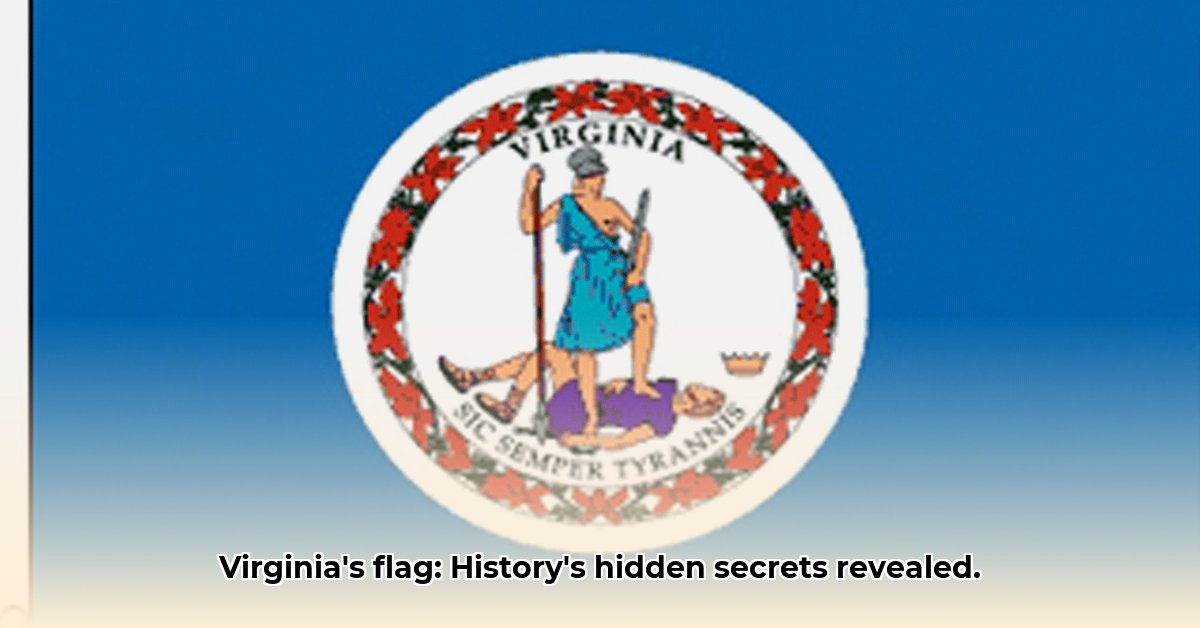The deep blue field of the Virginia state flag, emblazoned with the dramatic image of Virtus, the Roman goddess of virtue, triumphing over a fallen tyrant, represents far more than a simple state emblem. It’s a powerful symbol deeply interwoven with the state’s history, reflecting its revolutionary spirit, its complex role in the Civil War, and ongoing debates about its meaning and legacy. This article explores the intricate layers of symbolism, historical context, and contemporary controversies surrounding the Virginia flag, inviting readers to grapple with its multifaceted narrative. For comparison, see the complexities of other state flags, like the Oklahoma flag.
Deconstructing the Imagery: A Scene of Triumph and Ambiguity
The flag’s central image, derived from classical Roman iconography, depicts Virtus, armed with a spear and sheathed sword, standing victorious over a prostrate figure representing Tyranny. This powerful tableau immediately evokes Virginia’s fight for independence from British rule, a deliberate departure from traditional British heraldic designs. However, the identity of the fallen tyrant remains open to interpretation, contributing to the flag’s enduring ambiguity. Does it represent King George III, the target of colonial rebellion? Or does it embody a broader concept of oppression, encompassing the Confederacy, the Union during the Civil War, or even other forms of tyranny throughout history? This very ambiguity allows for multiple interpretations, shaped by individual perspectives and historical understanding. The fallen tyrant’s discarded crown and broken chain further symbolize the overthrow of monarchical power and the breaking of oppressive bonds.
The motto, Sic Semper Tyrannis (“Thus Always to Tyrants”), adds another layer of complexity. While echoing the revolutionary fervor and defiance of tyranny, its infamous association with John Wilkes Booth’s assassination of Abraham Lincoln casts a long shadow. This stark juxtaposition creates a challenging duality, prompting reflection on the motto’s varied interpretations and its implications for the flag’s overall meaning.
1861: Birth of a Flag in a Divided Nation
Understanding the Virginia flag requires examining the specific context of its creation in 1861, a pivotal year marking Virginia’s secession from the Union and its entry into the Confederacy. This historical moment undeniably shapes how we perceive the flag’s symbolism. The image of Virtus vanquishing Tyranny takes on new meaning when viewed through the lens of the Civil War. While the original designers may have intended a universal message of resistance against oppression, the flag’s adoption during this tumultuous period inextricably links it to the Confederacy and its subsequent legacy. This connection has fueled much of the modern debate surrounding the flag’s appropriateness and continued use.
The Evolving Narrative: A Symbol in Constant Flux
The meaning attributed to the Virginia flag has undeniably shifted over time, mirroring evolving societal values and historical interpretations. For some, it represents enduring principles of liberty, self-governance, and resistance to tyranny. For others, its association with the Confederacy and the enduring legacy of slavery overshadows any positive connotations. This dichotomy underscores the importance of acknowledging these diverse perspectives and fostering constructive dialogue about the flag’s intricate and often contested legacy. Exploring the flag’s significance within different communities across Virginia is crucial for a comprehensive understanding of its evolving narrative.
Beyond the Confederacy: Examining Other Interpretations
It’s essential to acknowledge interpretations of the flag that extend beyond its Confederate context. The reverse side of the seal, less frequently displayed but equally significant, features three Roman goddesses: Libertas (liberty), Ceres (agriculture), and Aeternitas (eternity). Together, they symbolize the blessings of freedom, prosperity, and enduring governance. The motto on the reverse, Perseverando (“Persevering”), reinforces the importance of upholding these values. Considering both sides of the seal offers a more nuanced understanding of the flag’s intended symbolism, encompassing not only the struggle against tyranny but also the aspiration for a prosperous and enduring republic.
The Ongoing Dialogue: Reimagining a Symbol for the Future
The ongoing debate about the Virginia flag reflects broader national conversations regarding Confederate symbols and their place in public life. While some advocate for preserving the flag as a historical artifact, acknowledging its complex history, others propose modifications or its complete replacement with a more inclusive and unifying symbol. This debate necessitates a deeper exploration of the flag’s meaning for all Virginians. How can the Commonwealth reconcile its complex past with its aspirations for a more equitable and representative future? The Virginia flag debate provides a critical platform for engaging with these challenging questions about history, identity, and the power of symbols in shaping our collective understanding.
- China II Review: Delicious Food & Speedy Service - April 17, 2025
- Understand Virginia’s Flag: History & Debate - April 17, 2025
- Explore Long Island’s Map: Unique Regions & Insights - April 17, 2025
















